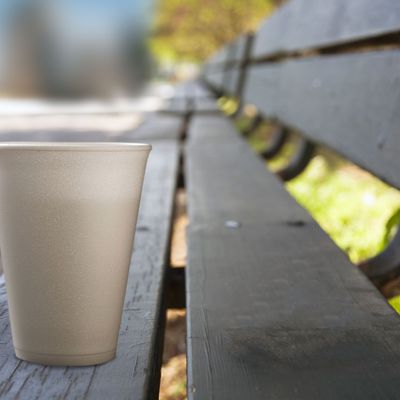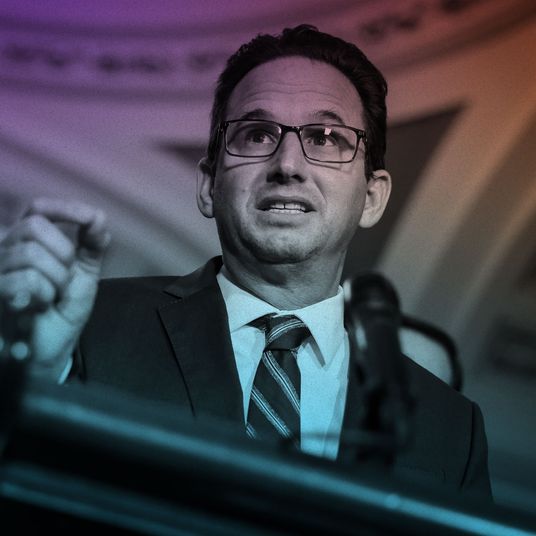
Giant-size sugary drinks will soon be vanquished, and smoking in indoor public spaces is already taboo. Now the latest enemy within, according to the Bloomberg administration, is the foam coffee cup. The mayor is looking to follow the lead of cities like Portland, and ban cups and takeout containers made of foam. (It’s styrene foam, not Styrofoam; the brand-name stuff is mostly building insulation.) The idea is understandable: Foam packaging lasts forever in landfills, and breaks up and gets into the soil and water, where it also lingers. Styrene has also been ID’d by the feds as a possible human carcinogen. But you know what? Banning styrene cups is a terrible idea.
The problem is that paper cups are in many ways just as bad for the environment as foam cups, and by some measures, they’re worse. For one thing, although they seem recyclable, they are not. The interior of your typical paper cup is coated with low-density polyethylene, labeled grade 4, which is not collected for recycling in New York City.
They’re both going in the landfill, either way.
Environmental issues are complicated and systemic, and a lot of the damage caused by a product is invisible to the consumer. Paper-making is a pretty nasty process. You have to cut down pulpwood forests. The factory stinks horribly. It consumes a lot of clean water, and expels a lot of dirty water. One estimate says that making a foam cup uses one twelfth as much water as making a paper cup — and water, as every environmentalist can tell you, is the next petroleum, a great resource over which people will eventually go to war.
But, you say, what about the fact that foam itself comes from fossil fuels? Oh, please. It takes two and a half times as much energy to make a paper cup as it does to make a foam cup. Foam cups are also much lighter than paper cups, reducing the amount of fuel needed to ship them to the store and to cart them away as trash. Foam also produces a lot less manufacturing waste, because there are no paper offcuts to discard.
And you use just one of them! Paper cups are often doubled up, or augmented with that sleeve meant to keep your hand cool, and that adds to the environmental impact even more. A foam cup, for all its flaws, is an excellent insulator. I might even propose that, because it keeps your coffee hot much longer, it wastes less energy that way, too, because you’ll toss out fewer cups gone cold. The definitive study of the energy equation was done by a guy named Martin Hocking, from Canada’s University of Victoria, and you can read a synopsis of it here. Suffice it to say that foam holds its own, and then some.
The one argument that holds water (so to speak) is the cancer discussion. But even there, the problem does not appear to be at the consumer level. It principally affects the people who make the stuff. The solution there is not to ban styrene; it’s to regulate the factories and keep employees from getting it into their bodies. OSHA does that, and potentially could do even more. (Lots of reading about that here.) And, once again, it’s a question not of absolutes but of alternatives: take a look at OSHA’s page about paper mills, which are pretty dangerous places themselves. Wielding a chainsaw in a pulpwood forest is, arguably, about as life-threatening as handling creepy plastics chemicals.
If we’re honest with ourselves, what is going on here is as much aesthetic as environmental. Paper cups feel cozy. The cardboard surface is pleasant in the hand; the rolled edge meets your lips nicely. If you happen upon a classic Anthora cup, you feel like a true New Yorker. If you’re at Starbucks, the barista can misspell your name smoothly on a cardboard surface with a Sharpie, instead of carving it awkwardly into the foam. Paper cups begin life in the hands of the aforementioned chainsaw-wielding loggers, who wear worker-honest Timberlands and flannel shirts. Like the Starbucks guys do, come to think of it.
Foam cups, by contrast, feel insubstantial and cheap. They blow around when they’re empty. The top edge is scratchy and thick when it meets your mouth. Foam products still, even after 50 years, feel a little bit space-age and unnatural, something you don’t enjoy touching. They’re not from forests; they’re reacted into existence somewhere mysterious, through processes you can’t see. Put one down on a counter when it’s empty, and it’s silent; you don’t get that nice little thunk that a paper cup produces. It’s the difference between Starbucks and Dunkin’ Donuts; it’s blue-state-red-state. Converse canvas sneakers vs. puffy white Reeboks. Paper cups are artisanal Brooklyn; foam cups are Staten Island. And reuseable vintage mugs are Green Party, and hard-core Park Slope. (Though if you read Hocking’s research, you may not even be sure of that, because it takes so much power to fire a piece of porcelain and then keep washing it in hot water. He found that you’d be better off using and discarding a thousand foam cups than one china mug, because of the energy costs. And don’t even talk to me about your stainless-steel travel mug. From an energy standpoint, you may as well be making it out of baby spotted owls.)
I’m stunned that Michael Bloomberg, of all people, fell for this. It’s not real technocratic policy-making, of the sort he excels at; it’s a bunch of lingering, reflexive hippie shit, and it belongs in the same compost bin with the screeds that begin “George Washington grew hemp, man!” You’d think he would be the last guy to fall for it. Mayor Mike: Can we talk about this? I’ll meet you at Viand, that coffee shop you like on the Upper East Side. Yes, they use paper cups. But we’ll get it to stay, in those thick, indestructible diner mugs.






























